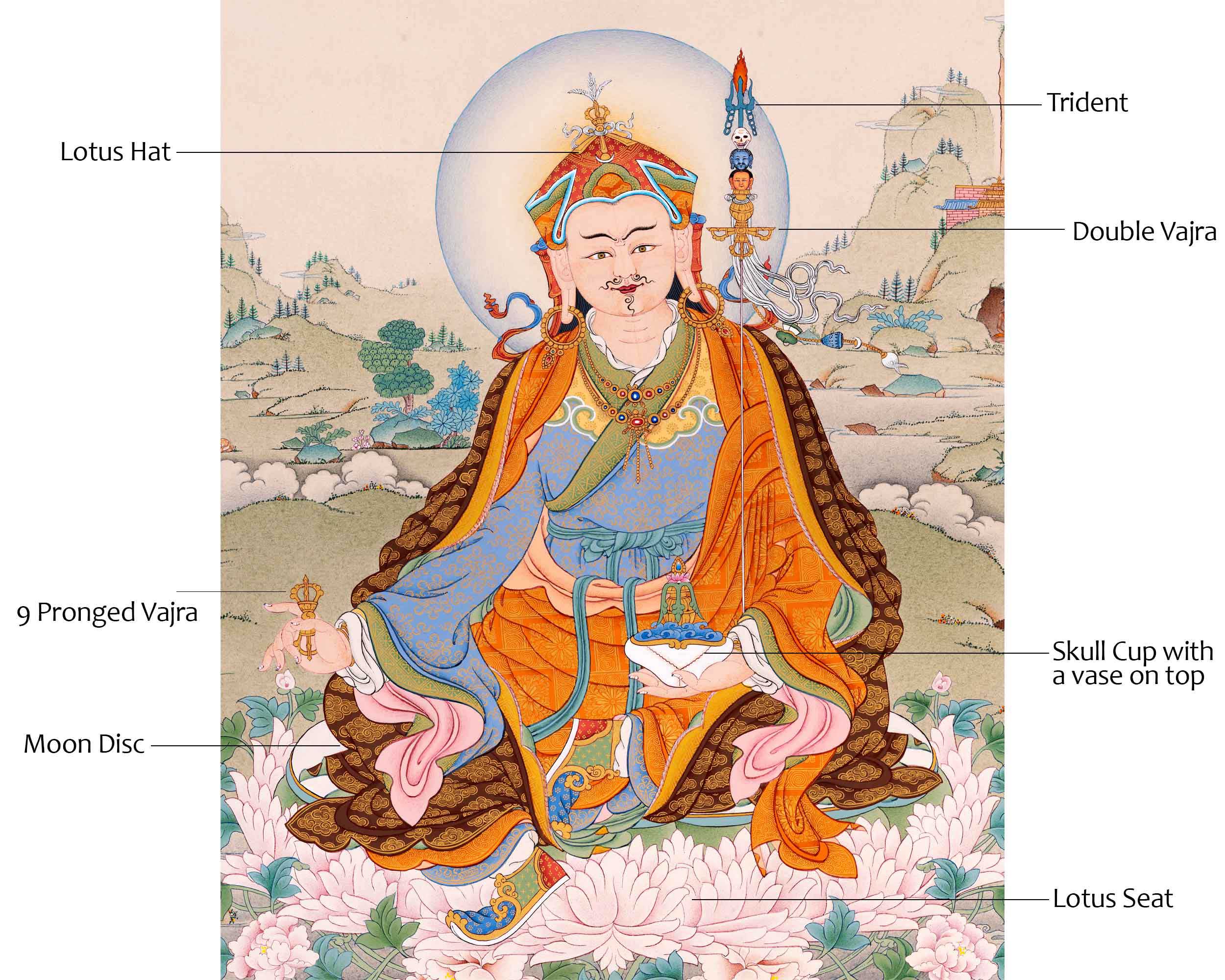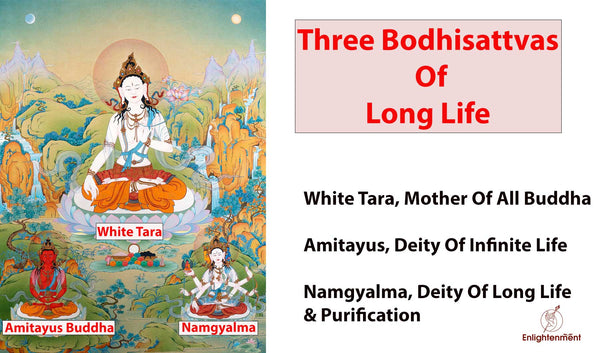The Copper Colored Mountain / Palace of Padmasambhava
Padma is a Sanskrit word meaning lotus flower. Sambhava translates as "born from." The Tibetan name for Padmasambhava is 'Pema Jungney,' a translation of his Sanskrit name Padmakara, which means "originated from a lotus."
The Buddha of Infinite Light's blessed light hit a lotus in the Milk Ocean, southwest of Bodhgaya, 12 years after the Buddha's Mahaparinirvana. According to Terma teachings, Padmasambhava magically manifested as an 8-year-old child sitting on a lotus flower and holding a vajra and a lotus.
Guru Rinpoche was, therefore, miraculously born through lotus birth without having human parents. Indrabhuti , the King of Oddiyana, and his Ministers came upon the infant while crossing the sea. When he arrived at the Palace, he was given the title Crown Prince.
Both when Padmakara was conceived from a lotus flower and when being guided by King Indrabhuti on his return journey, a lotus blossom appeared everywhere he placed his foot. "This child is certainly a lotus-born one," the king said." As a result, he gained the moniker Padmakara. The area of Oddiyana is recognized as the birthplace of Padmasambhava and has a long history of connections with tantric concepts of sacred geography.
Taking ordination from the Pandita Shakyabodhi, he was named 'Shakya Senge'. Later, after he attained enlightenment and ruled as the supreme leader of 500 great panditas, he was referred to as 'Padmasambhava, the Lotus-Born'.
The young Padmasambhava was taught all the knowledge arts and became proficient in all of them. Nevertheless, he soon left the royal Palace to dedicate his life to using esoteric knowledge and sacred power to aid sentient beings. Although he was a fully realized Buddha, he received countless transmissions from Dakini, non-human deities, and human knowledge-holders to underline the need to uphold Dharma. He spread those lessons to an infinite number of visible and invisible beings, and by using his unbreakable will, he defeated many evil forces that were obstructing his quest for enlightenment.
"12 years after my mahaparinirvana, a remarkable being with the name Padmasambhava will appear in the center of a lotus and reveal the highest teaching concerning the ultimate state of true nature, bringing great benefit to all sentient beings."
-Shakyamuni Buddha
A Lotus-Born Guru Rinpoche is a fully realized Buddha who has taken on the form of one of the greatest sages in the Vajrayana Buddhist tradition. He lived in the body of light and founded the new world of Zangdok Palri.
Guru Padmasambhava's Portrayal in Thangka
Click here to view our High Quality Guru Rinpoche Thangka Painting
Guru Rinpoche is portrayed artistically in every thangka. He is depicted as having one face with a wrathful or semi-wrathful facial expression and two hands. The eyes are wide open in a piercing gaze. He is seated in a royal posture. The surrounding around him is usually.
He has a lotus 5-petalled lotus hat. It is composed of 3 points that signify the 3 kayas, 5 colors that symbolize the 5 kayas, a sun and moon that portrays skillful means and wisdom, a vajra top that embodies unshakable samadhi, a vulture's feather to personify the realization of the highest view.
His body complex is white with a tinge of red. He has a cloak of silk, Dharma robes, and a gown- the dark blue gown of a practitioner, the red and yellow shawl of a monk, the maroon silk cloak of a king, and the secret white garments of the bodhisattva.
He holds a 5-pronged Vajra with his right hand, close to his heart, and the left-hand rest in the gesture of equanimity, holding a skull-cup brimming with nectar that also contains the vase of longevity, which is also filled with the nectar of deathless wisdom and has a wish-fulfilling tree perched on top. The Khatvanga is cradled on his left arm as well.
A distinctively heavenly quality of Padmasambhava, the khatavanga is fundamental to his iconographic representation. It is a danda with three severed heads, signifying the three kayas (the 3 Buddha bodies, the dharmakaya, sambhogakaya, and nirmanakaya), capped with a trishula, and draped in a ribbon representing the Himalayan Rainbow or the Five Pure Lights of the Mahabhuta. Practitioners use the imagery as symbols for underlying meanings in transmitted activities across the numerous Tantric cycles.
The Copper Coloured Mountain/ Palace: Zangdok Palri
Source: Nekhor Org
The pure land of Guru Rinpoche, the second Buddha, and the great tantric teacher who introduced Buddhism to Tibet, is Zangdok Palri, the Glorious Copper Colored Mountain. Guru Rinpoche is believed to reside in the pristine place which is said to be in Ngayab Ling. Raksha Thötreng, the rakshasa king, was set free by Padmasambhava on the summit of the Copper-Colored Mountain, where he also took on his form. As a "vidyadhara of spontaneous presence," the fourth vidyadhara level, he is currently residing in Zangdokpalri.
The Copper-Colored Mountain is where numerous and intricate systems of spatial ordering and definition intersect. By recognizing and separating the myriad strands woven together in this region, a great deal about Tibetan sacred space may be learned.
Buddha Amitayus represents the Dharmakaya level, four-armed Avalokiteshvara represents the Sambhogayaka level, and Guru Rinpoche represents the Nirmanakaya level. In the Himalayas, traditions centered on the desire to ascend to this Mountain and see Padmasambhava face to face are common forms of religious devotion since he, as an enlightened being, is believed to be still alive there. There are scores of accounts of individuals making visionary travels to the Copper-Colored Mountain, some of which give fairly precise routes.
Although the Copper Palace does not attempt to determine how the various names connected with Padmasambhava's destination relate to one another, the list offers a short index of the different geographies in which the Mountain is located. This article will approach each site not as a fixed location to be marked with GPS coordinates but rather as four different ways of conceptualizing the area of the Mountain by examining the contexts from which each of these four place names—Camaradvipa, Lanka, Oddiyana, and India—derives meaning.
The Copper-Colored Mountain is concurrently situated on the island Camaradvipa (also known as "Chowrie Island"), the demon-inhabited island of Lanka, close to the Oddiyana area, and, perhaps most broadly, in "the southwest."
It is possible to be reborn in the glorious realm of wisdom, power, and blessings known as the outer Zangdok Palri with the favorable traits needed to advance quickly on enlightenment. The Palace at Zangdok Palri, which has 4 gates, 4 arches, and 8 pillars, is modeled after an 8-sided gem and a 1000-petaled lotus. Walls built of priceless materials may be found in 4 directions: sapphire in the north, lapis lazuli in the south, and crystal in the east.
Each location has its history and contributes unique characteristics to the Copper-Colored Mountain's made-up universe. For instance, one of the intermediary continents (Skt. antaradvipa) described in the venerable Indian works on Buddhist cosmology is called Camaradvipa. The Indian legends of maritime merchants that made their way into collections of jataka and avadana stories introduced Tibetans to the demon-inhabited island of Lanka. Click here to view our Hand Painted High Quality Thangka Paintings
Click here to view our Hand Painted High Quality Thangka Paintings
Finally, the perception that the Mountain is situated inside the boundaries of India influenced the mapping work done by Tibetans in the 19th and 20th centuries once they got access to contemporary geography and cartography. These several maps of the Copper-Colored Mountain continue to connect and overlap in numerous ways, much like in the final chapters of The Copper Palace.
The mythical depiction of Padmasambhava's departure from Tibet makes for a logical position to explore the location of the Copper Colored Mountain. The last chapters of the Copper Palace (zangs gling ma), the most well-known account of Padmasambhava's life that is credited to the treasure-finder Nyangrel Nyima Oser of the 12th century, are structured around this departing scenario. Various disciples ask the guru to stay and give them the last word. Some of the oldest mentions of the Copper-Colored Mountain may be found in the verses of these conversations. In a few places, Padmasambhava's final resting place is specified as Cāmaradvīpa (rnga yab gling).
According to contemporary experts, the sites that are the last stops on these paths fall under the categories of geography, visionary landscape, and cosmography. The seamless layering of these many spatial mapping techniques provides a fantastic chance to investigate Himalayan Buddhist geographies and the cultural place-making processes shown in multiple attempts to find the Copper-Colored Mountain.


